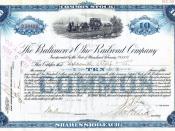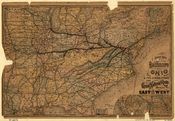The Effect of Steam Railroads on Life in 19th Century America Today in the 20th century, we Americans, think very little of our ability to move almost effortlessly from one place to another in America. This was far from the case in early 19th century America. The introduction of the Steam Railroad was the single most important technological change in 19th century America and would forever drastically change the American experience economically, socially and geographically.
Credit for invention of the practical Steam Railroad is generally given to George Stevenson of England in 1829. Stevenson is also claimed to be responsible for the too narrow, track gauge standard of 4'8 ÃÂý "� which was the distance between the wheels of a manure cart. (Martin 12) Stevenson's Railroad was originally used in the mining business in New Castle England to move coal in the yards and mines. (Jensen 13) The fist commercial non-experimental steam railroad in America was operated by the Delaware Hudson Canal Company.
The locomotive was named the Stourbridge Lion weighing seven tons and was built in England by Stevenson. On its maiden trip in August of 1829 over the 16 miles of track that had been laid, it was discovered that the engine was too heavy for the timber viaducts that sagged under its weight. The owners feared they would loose their investment and stored the Stourbridge Lion and left it there permanently (Withuhn 8) Nineteenth century America had a number of less successful modes of transportation in use before the invention of the Steam Railroad. Turnpikes were toll financed artificial roads that had a 5% grade and were ditched on both sides and crowned in the center for drainage. The majority of turnpikes radiated from eastern cities such as Philadelphia, Boston and New York and connected other surrounding...


